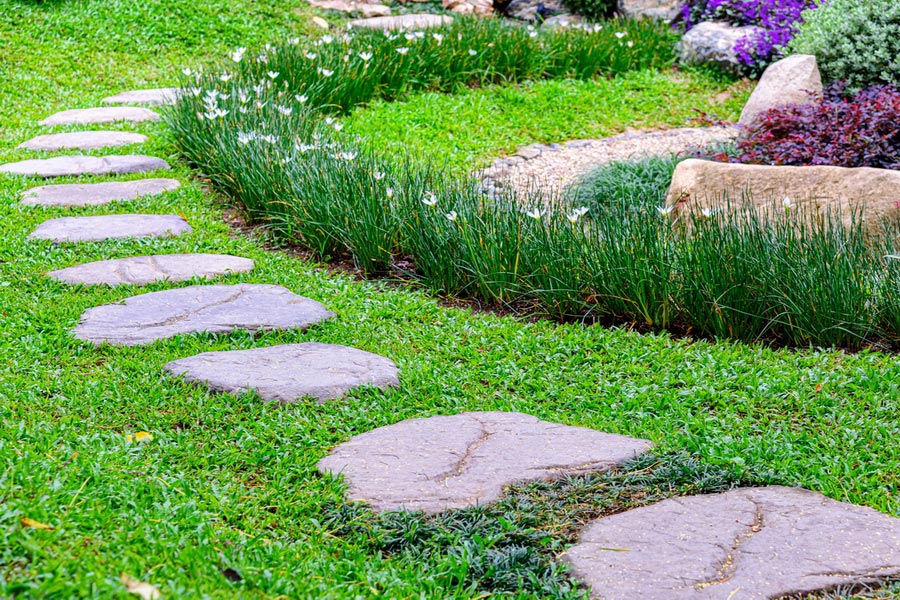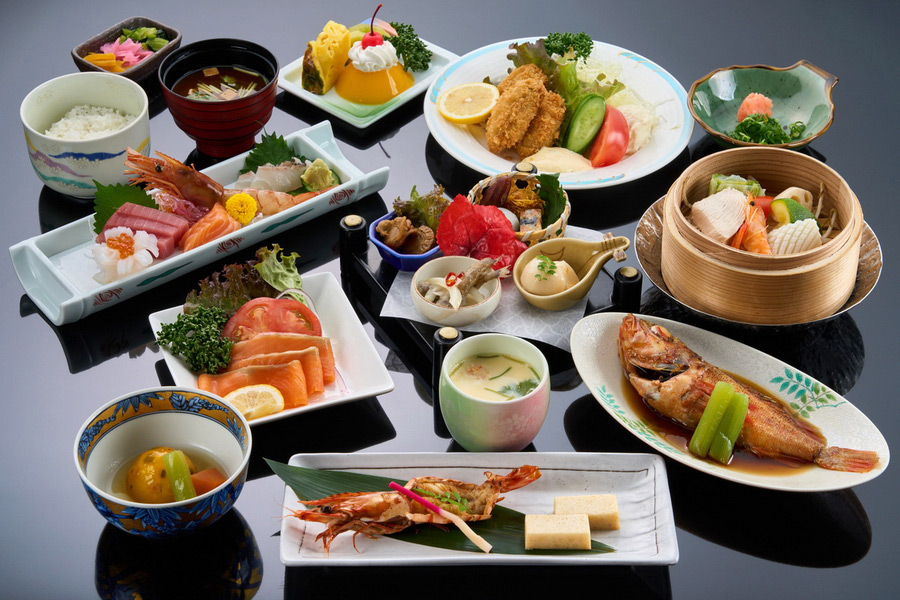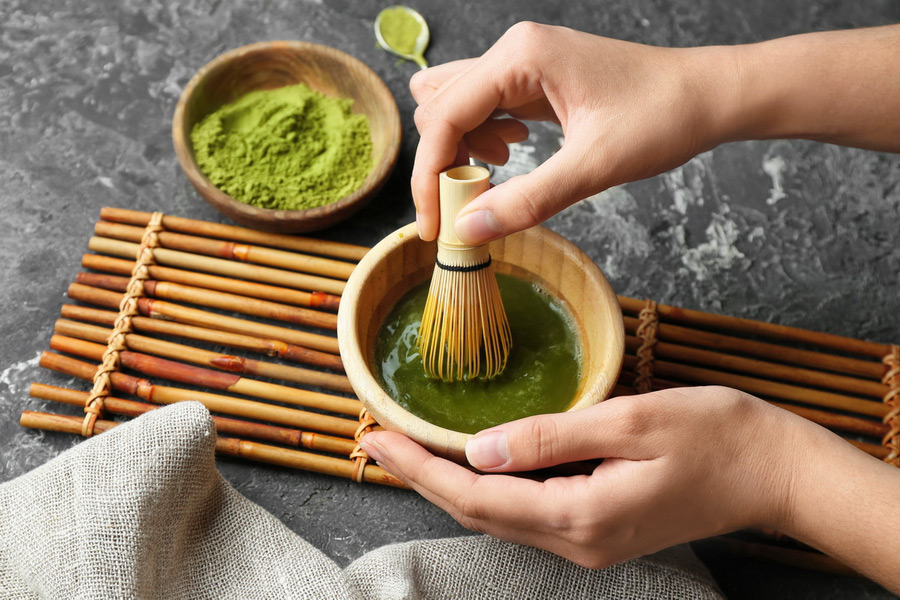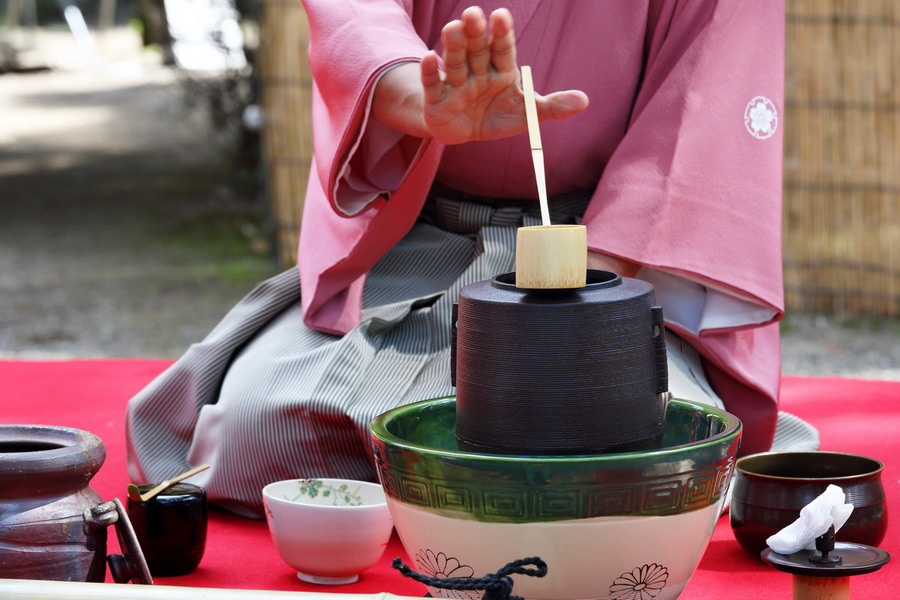
The ceremony is a way of worshipping the
beautiful and simple. All one's efforts are
concentrated on achieving perfection
through the imperfect gestures of daily life.
— Okakura Kakuzo
What to Expect from a Tea Ceremony
The Japanese tea ceremony is a graceful ritual known as chado (“the way of tea”) or chanoyu (“hot water for tea”). The purpose of the ceremony is to rid oneself of all worries, refresh the mind, and enjoy the present moment. It isn’t just about drinking tea; it is a traditional Japanese cultural practice that allows attendees to experience beautiful concepts of simplicity and see beauty in fleeting moments and Japanese hospitality.
Four Principles of the Tea Ceremony
Chanoyu can be best expressed through the four Zen principles of Sen no Rikyu: 1) be in harmony with others, 2) respect each other, 3) be pure, 4) be still. As Sen no Rikyu said: “When you hear the splash of the water drops that fall into the bowl, you will feel that all the dust of your mind is washed away.”
Before discussing the Japanese tea ceremony, let’s take a quick look at its historical context.
Brief History of Chanoyu

During the Kamakura period (1185-1333), the monk Eisai brought green tea seeds and Zen scriptures from China, promoting the tea tradition in Japan.
In the Muromachi period (1336-1573), Zen Buddhist monk Murata Juko integrated spirituality into the tea ceremony, utilizing simple tea rooms and utensils. He established the wabi-suki style (wabi meaning “simple” and suki “artistic inclination”), which later became known as wabi-cha. It emphasized simplicity and the unique relationship between the host and guest. However, chanoyu was mainly practiced by aristocrats, monks, and the samurai class.
- How was matcha made in the past? Monks would steam and grind matcha leaves into a paste, then bake and press them into hard blocks. Before enjoying the beverage, the Japanese would scrape from the blocks and make powder which they whisked with boiled water. The method, known as tencha, has survived to the present day.
Later, the great tea master Sen no Rikyu refined the wabi-cha aesthetic concept. He emphasized the construction of rustic tearooms and simple teaware, laying the foundation for the modern tea ceremony, which later spread among the public.
Since then, the Japanese have continued to express their sincere admiration for the beverage, and the ceremony has become a cornerstone of Japanese culture.
The Meiji government (1868-1912) declared the tea ceremony as a part of Japanese cultural heritage. Ordinary people and women began participating in chanoyu after the abolition of the samurai class.
What Happens at the Tea Ceremony?
The host of the tea ceremony prepares tea according to traditional etiquette and serves it to the guests. The Japanese tea used during chanoyu is called matcha, made from powdered tea leaves.
Below is a detailed description of the steps involved in a Japanese tea ceremony.
The Japanese Tea Ceremony Steps
Who goes first in a Japanese tea ceremony? How long does it take? What should you wear? Understanding all the nuances is crucial to being prepared for this tradition.
The event is hosted in traditional tea houses, which can be found on temple grounds, in Japanese gardens, and even in some shopping centers.
- Walk through the garden;
- Perform ritual cleansing;
- Take off your shoes before entering the teahouse;
- Sit in a kneeling position, called seiza (proper sitting);
- Be ready for a kaiseki dinner;
- Take a break after dinner;
- Listen to the story behind chado;
- Watch as the host prepares matcha and enjoy the tea;
- Thank the host for preparing the tea;
- After the ceremony, ask questions about tea utensils, history, and more.
On the Way to the Tea House

If held within the temple grounds, guests are led through the garden, which represents a passage connecting the waiting area and the tea house. According to Zen tradition, this walkway, "roji" (dew path), is meant to relax the mind and encourage tranquility before the ceremony.
- Tea houses are made from perishable materials like wood and bamboo, with thatched roofs that symbolize natural simplicity and the temporary nature of life.
Ritual Cleansing
As you proceed the path, you will reach a tsukubai area in the inner roji featuring a basin, a bamboo deeper, a stone lantern, and hot water. Here, one must bow down and rinse their mouths and hands. Guests keep walking, and upon reaching the tea house, they must take off their shoes to enter the room.
- The ritual cleansing of the mouth and hands before entering the tearoom signifies spiritual purification.
- When walking through the tearoom, be careful not to step on the edges of the tatami mats.
Kaiseki Dinner

A traditional multicourse meal, cha kaiseki, is usually served before the actual tea ceremony. When all guests are seated in a kneeling position, the host (teishu) kneels and bows gently to the guests before leaving the room through the sliding door. The host returns immediately with tea utensils, which each guest can examine briefly.
The host then leaves again to return and announce the meal is ready. As the ritual continues, the teishu leaves and returns with each guest's meal on a tray (oshiki). Each guest must bow and take their tray with both hands. The meal ends with the host serving sweets, either omogashi or wagashi.
- Kaiseki is a traditional Japanese meal often served at official ceremonies and Japanese-style restaurants. The meal at the tea ceremony is called cha kaiseki and is simpler than the standard Japanese ceremonial kaiseki.
- If chado doesn’t include kaiseki, guests will still be served sweets to open their palate to the bitter taste of the tea.
Nakadachi – The Middle Break
After finishing the kaiseki part, the host bows and leaves the room, and the guests go to the waiting lodge. The tea ceremony begins with the striking of a gong, signaling that the guests can return to the chashitsu.
Next to the host, seated on the tatami floor, are all the required items to implement chado:
- Chaire, a ceramic tea caddy with thick powdered green tea called koicha
- Chashaku, a bamboo scoop
- Mizusashi, a jar of cold water to refill the kettle
- A container for used water
- An incense holder
- A tea whisk called chasen
- Chakin, a linen napkin for wiping the tea bowl
- A tea bowl, chawan.
Introduction to the Way of Tea (Chado)
The host explains the meaning of the tea ceremony and points out the phrases written on the scrolls hanging in the tearoom. A popular one, "one chance, one opportunity" (ichi go ichi e), means we should appreciate each moment since it can never be duplicated. This concept is linked to Zen Buddhism.
Guests also learn about Sen no Rikyu, one of the great tea masters of the 16th century and author of the four principles of the tea ceremony: wa (harmony), kei (respect), sei (purity), and jaku (tranquility). Guests and hosts alike should embrace these ideas to fully enjoy the tea.
- The tea ceremony emphasizes the design of the tea room and the shapes of tea bowls and caddies, stemming from the idea that mere words are not enough to describe the beauty of chashitsu and tea utensils. Their beauty is rather expressed through their shapes.
Preparing Matcha

Everything is within reach, and the seated teishu first performs a ritual cleansing of the tea bowl, whisk, and tea scoop. Once done, the host begins making the tea by scooping powdered tea from the caddy into the tea bowl and adding boiling water from the kettle. The teishu then blends the tea and water using a bamboo whisk to make the beverage. The host bows in front of the guest while passing the bowl. The guest takes the bowl with the right hand, supporting it with the left palm, bows once, raises the bowl, takes a few sips, places it on the floor, and bows again. Everyone follows the same ritual when their turn comes.
On the guest’s side:
- Don’t drink the tea right away. First, rotate the bowl clockwise three times with the right hand to admire its beautiful design. The bowl’s front should face the host.
- Take three sips and make a slurping sound on the third sip. This way, you compliment the host for preparing delicious tea.
- Rotate the bowl counterclockwise three times to ensure the design faces the host again.
- Say “Thank you for making tea” in Japanese: “Otemae chodai itashimasu.”
The formal tea ceremony may involve drinking another bowl of matcha, typically thin tea (usucha). But if the guest doesn’t want to go for the second round, they can say: “Dozo oshimae kudasai” (“Please go ahead and finish”).
The End of the Formal Tea Ceremony
At the end of the chanoyu, the host cleans the utensils. Then, she kneels to open the door and leaves to conclude the ritual. When a tea master returns, guests can ask questions or comment on the surroundings. This is a more relaxed time where guests can enjoy sweets and conversation. However, do not take and eat sweets until they are offered. Appropriate topics to discuss include poetry, Zen aesthetics, tea flowers (chabana), and calligraphy. At this point, the guest can ask permission to look at utensils closely and inquire about their origins, history, and makers. Topics to avoid include money, illness, and politics.
- Unlike ikebana, where an artist intentionally arranges flowers that may come from greenhouses, flowers for the tea ceremony should be as they are in the field. Chabana often comprises wild in-season plants that grow in the mountains and are arranged as if picked from their natural surroundings.
Admire the Host’s Every Gesture

Watching a tea master or host, which can also be a geisha, is a true delight. The smooth pace and gentle movements during bows and serving of matcha deserve all the praise. What is all that choreography about? It’s about tranquility that can awaken one’s spirit and provide inner peace. It’s about selflessness when a host prepares tea but doesn’t drink it, focusing on omotenashi (hospitality) and pleasing the guest. In addition, chanoyu focuses on creating a special bond between the host and the guest, where both enter a state of mutual respect, harmony, and appreciation of every moment due to the transience of life.
How Long Does the Chanoyu Ceremony Last?
The formal ceremony (chaji) with cha kaiseki and two servings of tea can take 3-4 hours. This is the best option to experience the true spirit of chanoyu. Tokyo and Kyoto also hold shorter events (chakai) of approximately 45-50 minutes, usually involving only thin tea (usucha) without meals.
What to Wear to the Japanese Tea Ceremony?
While attending a Japanese tea ceremony, tourists of both genders are not strictly required to wear kimonos. Casual Western-style attire is acceptable. However, avoid wearing revealing or flashy clothing that may distract from the serene and contemplative atmosphere of the ceremony.
For the same reason, women and men should pay attention to their footwear. Prioritize comfortable, flat shoes or sandals that allow for easy movement and don't produce too much noise.
- You must remove any watches, rings, or jewelry to avoid damaging the tea utensils before entering the chashitsu.
- Additionally, don’t use perfume, tie up long hair, and set your phone to silent mode.

